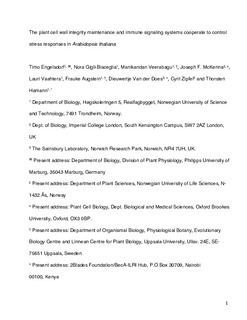| dc.contributor.author | Engelsdorf, Timo | |
| dc.contributor.author | Gigli, Nora | |
| dc.contributor.author | Veerabagu, Manikandan | |
| dc.contributor.author | McKenna, Joseph F. | |
| dc.contributor.author | Vaahtera, Lauri | |
| dc.contributor.author | Augstein, Frauke | |
| dc.contributor.author | van der Does, Dieuwertje | |
| dc.contributor.author | Zipfel, Cyril | |
| dc.contributor.author | Hamann, Thorsten | |
| dc.date.accessioned | 2019-03-01T11:06:24Z | |
| dc.date.available | 2019-03-01T11:06:24Z | |
| dc.date.created | 2018-08-03T15:40:53Z | |
| dc.date.issued | 2018 | |
| dc.identifier.issn | 1937-9145 | |
| dc.identifier.uri | http://hdl.handle.net/11250/2588228 | |
| dc.description.abstract | Cell walls surround all plant cells, and their composition and structure are modified in a tightly controlled, adaptive manner to meet sometimes opposing functional requirements during growth and development. The plant cell wall integrity (CWI) maintenance mechanism controls these functional modifications, as well as responses to cell wall damage (CWD). We investigated how the CWI system mediates responses to CWD in Arabidopsis thaliana. CWD induced by cell wall–degrading enzymes or an inhibitor of cellulose biosynthesis elicited similar, turgor-sensitive stress responses. Phenotypic clustering with 27 genotypes identified a core group of receptor-like kinases (RLKs) and ion channels required for the activation of CWD responses. A genetic analysis showed that the RLK FEI2 and the plasma membrane–localized mechanosensitive Ca2+ channel MCA1 functioned downstream of the RLK THE1 in CWD perception. In contrast, pattern-triggered immunity (PTI) signaling components, including the receptors for plant elicitor peptides (AtPeps) PEPR1 and PEPR2, repressed responses to CWD. CWD induced the expression of PROPEP1 and PROPEP3, which encode the precursors of AtPep1 and AtPep3, and the release of PROPEP3 into the growth medium. Application of AtPep1 and AtPep3 repressed CWD-induced phytohormone accumulation in a concentration-dependent manner. These results suggest that AtPep-mediated signaling suppresses CWD-induced defense responses controlled by the CWI mechanism. This suppression was alleviated when PTI signaling downstream of PEPR1 and PEPR2 was impaired. Defense responses controlled by the CWI maintenance mechanism might thus compensate to some extent for the loss of PTI signaling elements. | nb_NO |
| dc.language.iso | eng | nb_NO |
| dc.publisher | American Association for the Advancement of Science | nb_NO |
| dc.title | The plant cell wall integrity maintenance and immune signaling systems cooperate to control stress responses in Arabidopsis thaliana | nb_NO |
| dc.type | Journal article | nb_NO |
| dc.type | Peer reviewed | nb_NO |
| dc.description.version | acceptedVersion | nb_NO |
| dc.source.volume | 11 | nb_NO |
| dc.source.journal | Science Signaling | nb_NO |
| dc.source.issue | 536 | nb_NO |
| dc.identifier.doi | 10.1126/scisignal.aao3070 | |
| dc.identifier.cristin | 1599698 | |
| dc.description.localcode | © 2018. This is the authors' accepted and refereed manuscript to the article. The final authenticated version is available online at: http://dx.doi.org/10.1126/scisignal.aao3070 | nb_NO |
| cristin.unitcode | 194,66,10,0 | |
| cristin.unitname | Institutt for biologi | |
| cristin.ispublished | true | |
| cristin.fulltext | original | |
| cristin.qualitycode | 1 | |
